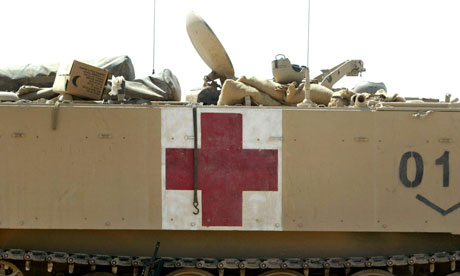Glowing bandage to treat infection
Military medics could use gel-coated dressing to identify wounds sustained in the field that have become infected
Press Association
guardian.co.uk, Thursday 15 September 2011 20.51 BST

Military medical personnel could use the glowing bandage to identify wounds that had become infected. Photograph: Murad Sezer/AFP/Getty Images
======================================================
A wound dressing that glows to indicate an infection could be tested on patients within two years after scientists developed a gel containing molecules that bind to bacteria and activate a fluorescent dye.
Illuminated by an ultraviolet lamp, the dressing emits a pinkish glow when harmful levels of bacteria are present. Doctors can then make the best decision about how to treat the wound.
Army medics could use it to identify soldiers with infected battlefield injuries and part of the funding for the research has come from the Ministry of Defence.
Professor Sheila MacNeil, one of the researchers at the University of Sheffield, said: "If you know you've got infection, it's going to change how you treat your soldiers, it's going to change how you're going to treat those patients in the home.
"If it's a high-level infection, they're going to need antibiotics rapidly. If it's a low-level infection, the best thing to do with a chronic wound is hold off on the antibiotics, clean the wound out, reduce the bacteria."
She added: "We could get to an early-stage clinical trial in two to three years."
Currently, it takes several days to determine significant levels of bacterial infection by growing swab samples in the laboratory.
The dressing uses polymers – long-chain molecules – attached to antibiotic fragments which naturally bind to bacteria. Once the molecules attach to the microbes, the polymers collapse around them, triggering the fluorescent signal. The gel-coated dressing is left on a wound for around a day and then peeled off.
As well as shining a spotlight on bacteria, the gel can rid a wound of up to 80% of surface bugs in around three hours.
Project leader Dr Steve Rimmer, also from the University of Sheffield, said: "The availability of these gels would help clinicians and wound-care nurses to make rapid, informed decisions about wound management, and help reduce the overuse of antibiotics."
Military medics could use gel-coated dressing to identify wounds sustained in the field that have become infected
Press Association
guardian.co.uk, Thursday 15 September 2011 20.51 BST

Military medical personnel could use the glowing bandage to identify wounds that had become infected. Photograph: Murad Sezer/AFP/Getty Images
======================================================
A wound dressing that glows to indicate an infection could be tested on patients within two years after scientists developed a gel containing molecules that bind to bacteria and activate a fluorescent dye.
Illuminated by an ultraviolet lamp, the dressing emits a pinkish glow when harmful levels of bacteria are present. Doctors can then make the best decision about how to treat the wound.
Army medics could use it to identify soldiers with infected battlefield injuries and part of the funding for the research has come from the Ministry of Defence.
Professor Sheila MacNeil, one of the researchers at the University of Sheffield, said: "If you know you've got infection, it's going to change how you treat your soldiers, it's going to change how you're going to treat those patients in the home.
"If it's a high-level infection, they're going to need antibiotics rapidly. If it's a low-level infection, the best thing to do with a chronic wound is hold off on the antibiotics, clean the wound out, reduce the bacteria."
She added: "We could get to an early-stage clinical trial in two to three years."
Currently, it takes several days to determine significant levels of bacterial infection by growing swab samples in the laboratory.
The dressing uses polymers – long-chain molecules – attached to antibiotic fragments which naturally bind to bacteria. Once the molecules attach to the microbes, the polymers collapse around them, triggering the fluorescent signal. The gel-coated dressing is left on a wound for around a day and then peeled off.
As well as shining a spotlight on bacteria, the gel can rid a wound of up to 80% of surface bugs in around three hours.
Project leader Dr Steve Rimmer, also from the University of Sheffield, said: "The availability of these gels would help clinicians and wound-care nurses to make rapid, informed decisions about wound management, and help reduce the overuse of antibiotics."
=================================================
guardian.co.uk/science/2011/sep/15/glowing-bandage-treat-infection
No comments:
Post a Comment